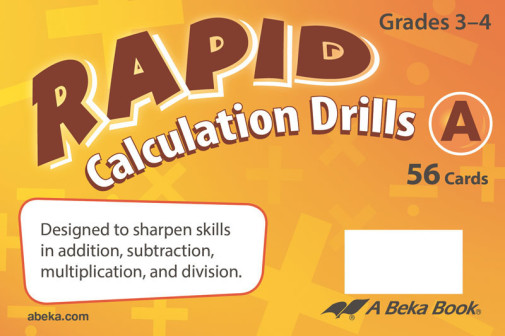We use cookies to make your experience better. To comply with the new e-Privacy directive, we need to ask for your consent to set the cookies. Learn more.
Rapid Calculation Drills A
Rapid Calculation Drills are designed to sharpen skills in addition, subtraction, multiplication, and division. Easy to use at home before Math class to get the wheels moving, but versatile enough to take along during the car ride or waiting at a doctor's appointment. Students love the challenge of trying to solve problems mentally and quickly. Tailored for grades 3-4, but the drills could also be used by older grades to sharpen skills. ~Amber
What does 12 x 7 – 14 ÷ 7 + 4 equal? Or how about 3/9 - 2/9 + 6/9? Your class will love racing to answer as they sharpen their skills in addition, subtraction, multiplication, and division. These 56 cards make it easy to test and review your students' ability to mentally solve math problems quickly and accurately.
Rapid Calculation Drills A is specifically called for in the grades 3 and 4 Arithmetic Curriculum/Lesson Plans. Each 4" x 6" card contains several exercises on the front and back. The set includes 102 exercises for grade 3, and 66 exercises for grade 4, with each exercise containing several problems.
Although new to our catalog, this math curriculum is certainly not new to the homeschool community. Abeka has been a tried-and-true math program amongst homeschoolers for many years. Taking a traditional, spiral approach, this series presents math concepts at the simplest level and builds on those concepts each year while offering continual review so students can fully grasp the concepts being taught. Abeka also teaches math from a faith based worldview and integrates biblical application throughout the program.
The elementary math lays a solid foundation for the higher level mathematics, and emphasizes oral and written drill. For the younger grade levels, the lesson instruction includes visual aids, games and activities. As the grades progress, the lessons become more independent but are still teacher directed. For Kindergarten, a worktext and teacher key is available along with several manipulative components. Math kits for grades 1-6 are sold in a child and parent kit (each sold separately). The child kit includes the consumable worktext and a test/speed drills book. The contents of the parent kit vary depending on the grade level; however all will include a curriculum guide for lesson plans as well as answer keys for the worktext and test/speed drills. It is suggested to purchase both the student and parent kits for a full math curriculum. The curriculum guide incorporates flashcards/charts into some of the lessons. These are available to purchase separately.
Junior high moves toward Intermediate Mathematics and PreAlgebra. Worktexts at these levels are still consumable. Intermediate Mathematics is a new and improved seventh grade course, reviewing all math skills previously learned while introducing algebra and geometry. This new course focuses more on understanding the concepts rather than just memorizing. The Intermediate Kit includes the worktext and test/quiz book. A teacher edition, solution key, supplemental exercises book and key are all available for this level. The newly revised PreAlgebra text continues with review and bridges the gap between basic mathematical concepts and more advanced topics. This level has a worktext, quiz/test book and key, teacher edition, and solution key.
High school levels include Algebra 1 through Precalculus. Concepts are taught in a clear, logical order with detailed explanations and step-by-step examples. Student textbooks are non-consumable at this level. Each section has practice problems taught in that section and review problems from previous sections. A teacher edition (to help guide your student through the courses), solution key, quiz/test book and key are also available for each course.
Abeka Math is a solid, traditional math program with a biblical focus. Each year builds upon the previous while continuing to review. The math facts are drilled and mastered at the elementary levels so students can be confident and successful in subsequent levels. The review can move rather quickly; therefore if your student is moving into Abeka from another program, you should consider taking a look at the scope and sequence before deciding where to start in the series.
Concepts include place value of whole numbers and decimals; mastery of fundamental operations; story problems; estimating answers; English and metric measures; converting measures within the same system and solving measurement equations; Roman numerals; addition, subtraction, and multiplication involving fractions; estimation, averaging, factoring, divisibility rules, introduction to decimals, making change; reading a thermometer, solving equations using addition and subtraction axioms; graph and scale drawing; basic geometric shapes; perimeter and area; using an English and metric ruler; time lapse. 170 lessons
| Product Format: | Paperback |
|---|---|
| Brand: | A Beka Book |
| Grade: | 4 |
| Length in Inches: | 4 |
| Width in Inches: | 6 |
| Height in Inches: | 0.3125 |
| Weight in Pounds: | 0.2 |

